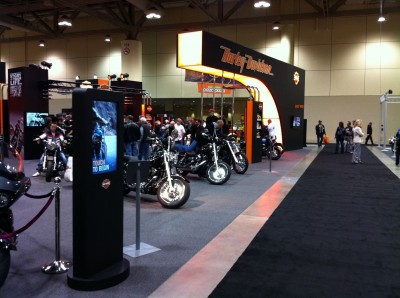By Peter Saunders
Deeley Harley-Davidson Canada, the exclusive Canadian distributor of Harley-Davidson motorcycles, parts and accessories, has a coveted market position. With offices in Richmond, B.C., and Concord, Ont., it represents a well-known brand that has been embraced by millions of riders around the world as a lifestyle.
Yet, this position comes with business challenges, as it is still important to reach out to new consumers, while also forging stronger bonds with a wide range of existing customers. It can be difficult to communicate with the right group at the right time.
In recent years, Deeley has seen an opportunity to use digital signage kiosks to help fulfil this mandate, both in-store and on-location at trade shows (example pictured) and other events. Among its marketing benefits, the medium could provide instant access to a full catalogue of Harley-Davidson motorcycle models and branded clothing and gear, welcoming everyone to the experience while remaining relevant and engaging to individual tastes.
It was equally important to track the effectiveness of the interactive kiosks to measure Deeley’s return on investment (ROI). The digital signage integrator, Planet-Tek Systems in Richmond Hill, Ont., used Intel’s Audience Impression Metrics (AIM) Suite—originally developed by Toronto-based CognoVision, before it was acquired by Intel in 2010—to detect the number of people looking at the displays, guess their gender and age and measure their dwell time, all without recording images, recognizing faces or capturing any personal information.
“We wanted to learn how to make this technology a part of our strategy to collect metrics about audience engagement, mine consumer data through viewing patterns and help shoppers navigate through what can be a busy environment,” says Aileen White, Deeley’s manager of retail environments and consulting services.
A small sensor was embedded in each kiosk display and connected to a computer running the software. The measured and aggregated data was then uploaded to cloud-based servers, allowing Deeley’s staff to view the results in a standard web browser.
The software was also tied to the digital signage content, allowing Deeley to test different concepts—along with different kiosk locations—at Canadian motorcycle shows to see which approach would be most successful.
“The next steps are to determine how we can integrate the results in all facets of our business and better understand the investment required for a national rollout,” says White.






